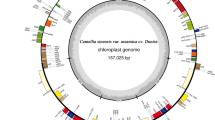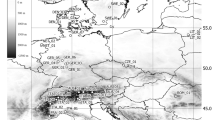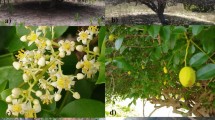Abstract
The evolutionary relationships of 186 accessions ofCapsicum from Mexico were studied through enzyme electrophoresis. A total of 76 alleles representing 20 genetic loci coding for nine enzyme systems were observed and the allelic variations of enzymes were studied for geographical distribution. Allele frequencies were used to estimate the apportionment of gene diversity within and between populations and to construct a dendrogram based on a similarity matrix containingNei genetic distances. — The gene diversity estimates suggest that the structure ofCapsicum populations in Mexico consists of predominantly homozygous genotypes presumably due to a self-pollinated breeding system and population bottlenecks. Significant genetic differentiation was found mainly between populations of differing geographical regions.—Based on the results of this study, three species of domesticatedCapsicum can be identified in Mexico,C. annuum var.annuum, C. chinense, andC. pubescens. Semidomesticated and wild forms include two species,C. frutescens andC. annuum var.glabriusculum. A sharp geographical division results between the latter species;C. frutescens was collected exclusively in the southeastern states of Oaxaca, Chiapas, and Tabasco; whereas wild and semidomesticated forms from the rest of the country areC. annuum. Based upon the similarity of enzyme genotypes of semidomesticated and wild forms, the primary center of domestication of cultivatedC. annuum was estimated to be the region comprising the states of Tamaulipas, Nuevo Leon, San Luis Potosi, Veracruz, and Hidalgo in eastern Mexico. A possible second center of domestication is suggested to be localized in the state of Nayarit, western Mexico.
Similar content being viewed by others
References
Allard, R. W., 1975: The mating system and microevolution. — Genetics79: 115–126.
Ayala, F. J., 1982: Population and evolutionary genetics: a primer. — Menlo Park, California: The Benjamin/Cummings Publishing Company.
—, 1974: Genetic differentiation during the speciation process. — Evolution28: 576–592.
D'Arcy, W. G., Eshbaugh, W. H., 1972: The name for the common bird pepper. — Phytologia25: 350.
—, —, 1974: New World peppers (Capsicum-Solanaceae) north of Colombia: a resume. — Baileya19: 93–105.
Eshbaugh, W. H., 1968: A nomenclatural note on the genusCapsicum. — Taxon18: 51–53.
—, 1970: A biosystematic and evolutionary study ofCapsicum baccatum (Solanaceae). — Brittonia22: 31–43.
—, 1976: Genetic and biochemical systematic studies of chili peppers (Capsicum-Solanaceae).12. — Bull. Torrey Bot. Club102: 396–403.
—, 1980: The taxonomy of the genusCapsicum. — Phytologia47: 153–166.
Flannery, K. V., 1973: The origins of agriculture. — Ann. Rev. Anthrop.2: 271–310.
Genetic Resources ofCapsicum, 1983. — Rome: International Board for Plant Genetic Resources — Rome.
Hartl, D. L., 1981: A primer of population genetics. — Sunderland, Mass.: Sinauer Associates.
Heiser, C. B., 1964: Los Chiles y Ajies de Costa Rica y Ecuador. — Ciencia y Naturaleza7: 50–57.
—, 1969: Names for the cultivatedCapsicum species (Solanaceae). — Taxon18: 277–283.
—, —, 1975: Names for the bird peppers (Capsicum-Solanaceae). — Baileya19: 151–156.
—, 1948: Observations on another species of cultivated pepper,C. pubescens R. & P. — Amer. Soc. Horticult. Science52: 331–335.
—, —, 1958: New species ofCapsicum from South America. — Brittonia10: 194–201.
Hunziker, A. T., 1979: South AmericanSolanaceae: a sypnoptic survey. — InHawkes, J. G., Lester, R. N., Skelding, A. D., (Eds.): Biology and taxonomy of theSolanaceae, pp. 49–85. — New York: Academic Press.
Jensen, R. J., McLeod, M. J., Eshbaugh, W. H., Guttman, S. I., 1979: Numerical taxonomic analyses of allozymic variation inCapsicum (Solanaceae). — Taxon28: 315–327.
Laborde, Jose, A., Octavio Pozo Campodonico, 1984: Presente y Pasado del Chile en Mexico. — Publication Especial Num. 85; 1 a. Reimpresion. INIA-SARH. Mexico.
McLeod, M. J., 1977: A systematic and evolutionary study of the genusCapsicum. — Ph.D. Dissertation, Miami University, Oxford.
—, 1979: Preliminary biochemical systematic study of the genusCapsicum-Solanaceae. — InHawkes, J. G., Lester, R. N., Skelding, A. D., (Eds.): The biology and taxonomy of theSolanaceae, pp. 701–714. — New York: Academic Press.
Munoz Flores, I., Pinto Cortez, B., 1966: Taxonomy and geographical distribution of the peppers grown in Mexico. — Proc. Amer. Soc. Hort. Sci. Caribbean Region10: 131–147.
Nei, M., 1972: Genetic distance between populations. — Amer. Naturalist106: 283–292.
—, 1973: Analysis of gene diversity in subdivided populations. — Proc. Natl. Acad. Sciences U.S.A.70: 3321–3323.
—, 1976: Mathematical models of speciation and genetic distance. — InKarlin, S., Nevo, E., (Eds.): Population genetics and ecology, pp. 723–765. — New York: Academic Press.
—, 1977: F-statistics and analysis of gene diversity in subdivided populations. — Ann. Human Genet.41: 225–233.
—, 1978: Estimation of average heterozygosity and genetic distance from a small number of individuals. — Genetics59: 583–590.
Pickersgill, B., 1971: Relationships between weedy and cultivated forms in some species of chili peppers (genusCapsicum). — Evolution25: 683–691.
—, 1977: Chromosomes and evolution inCapsicum. — InPochard, E., (Ed.):Capsicum 77. — Comptes Rendus du 3° Congres EUCARPIA sur la Genetique et la Selection du Piment, Avignon-Montfavet, France; pp. 27–37.
—, 1976: Cytogenetics and evolutionary change under domestication. — Phil. Trans. Roy. Soc. LondonB 275: 55–69.
—, —, 1979: Numerical taxonomic studies on variation and domestication in some species ofCapsicum. — InHawkes, J. G., Lester, R. N., Skelding, A. D., (Eds.): The biology and taxonomy of theSolanaceae, pp. 679–700. — New York: Academic Press.
Rick, C. M., 1983: Tomato (Lycopersicon). — InTanksley, S. D., Orton, T. J., (Eds.): Isozymes in plant genetics and breeding B, pp. 147–166. — Amsterdam: Elsevier.
—, 1977: Genetic variation inLycopersicon pimpinellifolium: evidence of evolutionary change in mating systems. — Pl. Syst. Evol.127: 139–170.
Smith, P. G., 1951a: Deciduous ripe fruit character in peppers. — Proc. Amer. Soc. Horticult. Science57: 343–344.
—, 1951b: Taxonomic and genetic studies on the cultivated peppers,C. annuum L. andC. frutescens L. — Amer. J. Bot.38: 362–368.
—, —, 1957: Taxonomy ofCapsicum sinense Jacq. and the geographic distribution of the cultivatedCapsicum species. — Bull. Torrey Bot. Club84: 413–420.
Sneath, P. H., Sokal, R. R., 1973: Numerical taxonomy: the principles and practice of numerical classification. — San Francisco: Freeman.
Tanksley, S. D., 1984: Linkage relationships and chromosomal locations of enzyme-coding genes in pepper,Capsicum annuum. — Chromosoma89: 352–360.
Vallejos, C. E., 1983: Enzyme activity staining. — InTanksley, S. D., Orton, T. J., (Eds.): Isozymes in plant genetics and breeding A, pp. 469–516. — Amsterdam: Elsevier.
—, 1983: Segregation of isozyme markers and cold tolerance in an interspecific backcross of tomato. — Theor. Appl. Genet.66: 241–247.
Wright, S., 1978: Evolution and the genetics of populations4. Variability within and among natural populations. — Chicago: University of Chicago Press.
Author information
Authors and Affiliations
Rights and permissions
About this article
Cite this article
Loaiza-Figueroa, F., Ritland, K., Cancino, J.A.L. et al. Patterns of genetic variation of the genusCapsicum (Solanaceae) in Mexico. Pl Syst Evol 165, 159–188 (1989). https://doi.org/10.1007/BF00936000
Received:
Issue Date:
DOI: https://doi.org/10.1007/BF00936000




